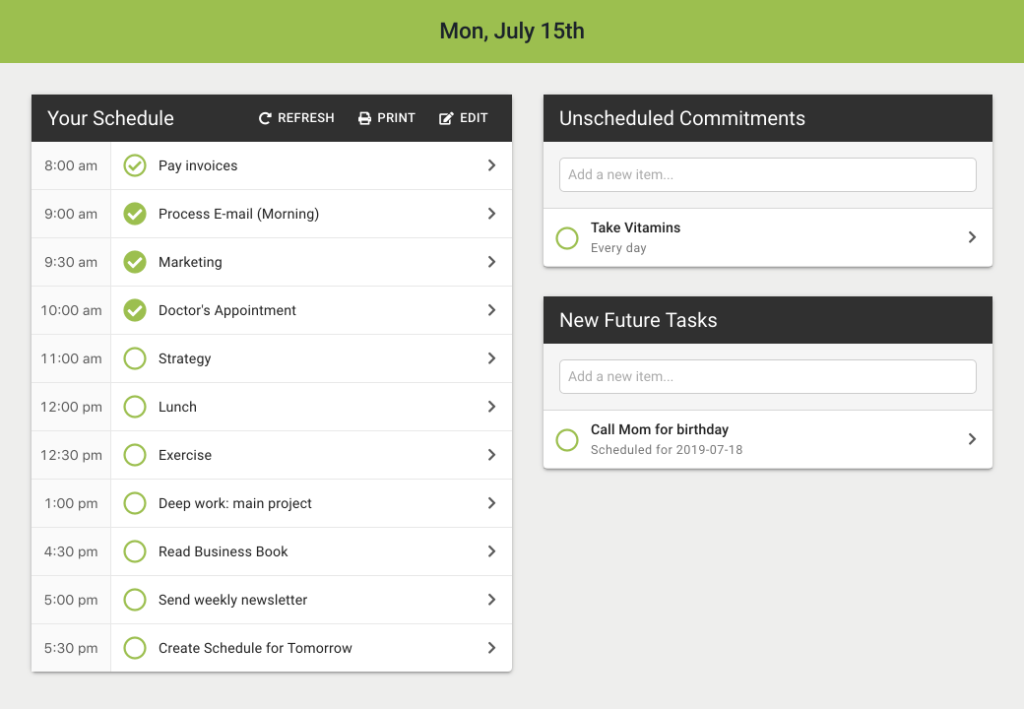Too often when we tackle a task, we attempt to finish it. Most of the time, that’s a good thing.
But the converse is also true: often we won’t start a task because we don’t have time to finish it. And that can lead to missed opportunities.
Staging areas give us a place to prep tasks or put half-finished work, allowing us to get started on tasks we otherwise wouldn’t, or to remove the cognitive load of having to remember the task in the first place.
Use staging areas to stage:
- Collect items to organize, put away or sort through
- Prepare items you’ll need later in the day, like exercise clothes
- Store work in progress when you switch to a different task
Two Types of Staging Areas
Staging areas can be used to bring your attention toward items or to let you forget about them so you can focus on the task at hand.
Put staging areas for items you need to remember in an area that is visible in your daily routine. For instance, lay out your exercise clothes on a chair in your office to remind you to hit the gym, or save a file to your desktop that you need to work on later today.
Put staging areas for items you want to forget in a place that is out of the way—but not so out of the way that you’ll completely forget about it. For instance, stage items to put away in a side room, or put files from other tasks you’re working on into a folder called In Progress on your desktop.
When choosing where to put your staging area, consider how frequently you’ll see the area. You want a balance between seeing it often enough so you remain aware of it, but not so often that it intrudes on your thought processes, adds stress and distracts you.
A Staging Area is Not a Backlog
Be careful about letting staging areas pile up; if they get too large, move the items you won’t process soon to a separate backlog area or put them away where they belong until you are ready to use them. Staging areas should be for things you’ll tackle soon, not a dumping area of everything you want to do but don’t have time for.
If you have a lot of items you’re not actively working, I recommend thinking in terms of four categories:
- Next
Tasks to work on next once you’re finished your current task, or in-progress tasks you will resume shortly. - Soon
Tasks to work on within the next couple days to couple weeks. - Later
Tasks to work on within the next couple weeks to couple months. - Future
Tasks to work on at an indefinite time in the future (usually 6+ months).
I’ve changed my definitions of the timeframes used for these over the years, so choose whatever works best for you. But it can be helpful to thing about tasks in these four rough areas.
To maintain your focus and attention, use staging areas only for the Next category. The remainder are backlogs; the things you need for those tasks should be stored away until you’re ready to work on those tasks.
A Few Last Tips
Some final tips for working with staging areas:
- Move items to your staging area while doing other things
Moving an item to a staging area is far less cognitively demanding than starting a task. Remove the cognitive drag in your environment by moving items to their appropriate area whenever you’re heading in that direction anyway. While it’s a small thing, those small things add up to quickly remove stress and improve our focus. - Use a bookmark folder to stage things to read, research & review
Create a folder where you can bookmark all web sites related to a task you are working on. Add bookmarks to this folder when you run across other sites you’ll need to review when starting or resuming the task. If you’re working on a task and need to switch to a different one, use the Bookmark All feature of your web browser to bookmark all the tabs in the current window. I store all these in a top-level folder on my bookmarks bar called Workspaces for easy access. - Reset your staging areas from time to time
If you aren’t able to process all the items from your staging area, from time to time move them to a backlog area and create a fresh start with your staging area. You can always move back items which you plan to tackle soon. For instance, I drag all the items on my desktop that I’m not working on this week into a To Process folder, which allows me to not forget them, but also to get them out of my attention field.
In Summary
Staging areas can be used to inspire you to start an activity (like going for a run), to collect things you’ll need to process in the future (like items to clean or organize) or to keep works in progress (like articles being written).
Pay attention to the visibility of the staging area based on what you are aiming to achieve with it. More visibile areas are better for inspiration and to trigger immediate action, while less visible areas are better for deferring tasks until later and removing them as distractions.
Finally, when you create a staging area, think strategically about how you’ll use it to direct your focus toward or away from the items you place there.








